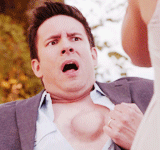The scene I have chosen to do from this
movie is undoubtedly my favorite scene within it. Even among all of the
frivolous and extraordinarily intense action scenes, my favorite scene begins
at 1 hour 42 minutes and 30 seconds into the film, it depicts Thor’s last
effort to convince his brother, not to surrender, but to stop, to amend and to
go home.
For the first time, we see Loki at equal
level with another character.
Throughout the movie, we’ve only ever seen
him faces with offensive affronts, and confrontational contact, or the camera
angle has placed us at a low point, aiming for a high angle shot, enhancing his
superiority, or extreme close-ups that are quite frankly, deeply unsettling.
So, as I’ve said earlier, equal footing,
for the first time throughout the movie:
The camera shows both Loki and Thor,
flickering back and forth between the two.
The lighting is deliberately bright at this
scene, and also very deliberately
done with a close-up shot, so you could clearly see all of the facial features
of the two characters.
A shot of a decimated New York is then
shown just as Thor shouts, “Look at this! Look around you!”, to Loki, pleading
with his brother to see reason, to realize the severity of the situation.
This long-shot CGI shot of New York makes
US realize the severity of the damage caused, and that will be caused just as
much as Thor is aiming for Loki to see, as we see this from Loki’s point of
view, as he glances over. The fact that a point-of-view shot is added puts us
for once in a position where we are able to empathize wit Loki. This is
essential due to what unfolds further on in the scene.
The rest of the scene depicts a heated
conversation between brothers.
Now, for my favorite part, the intricacy of
this astounds me:
Tom
Hiddleston (Loki) has very clear, blue eyes. In Avengers, this is enhanced:
This is probably to mimic the effect his
scepter has upon whom it touches, indoctrinating them with information solely
for the purpose of helping Loki, and in turn, making their eyes a sharp,
ethereal blue.
There is a theory that this may suggest,
sub-textually, that Loki was under the violating influence of the Tesseract the
entire time. The Tesseract is a burden, it gives those who touch it false,
malevolent purpose, and as Loki says: “I am Loki, and I am burdened with
glorious purpose”. (My favorite line)
This
scene is actually supportive of this theory.
Back to the eyes – So Tom Hiddleston’s eyes
are an enhanced blue, this is most apparent when he’s at his most evil, the
coldest and most antagonistic.
Now, there’s something I must make clear; I
personally don’t believe that Loki is inherently evil. He is a Norse God, the
God of Mischief, the Trickster. All of which are not embodiments of evil, which
I obviously do not believe him to be. With Loki, Joss Whedon creates a perfect
Xanatos Gambit, because even though Loki portrays that he is set out to destroy
Earth, the truth is, he couldn’t care less about the Midgardian world of Earth!
All he wants is to go home. So, win or loose the prizefight, Loki still goes
home, so Loki still wins.
Because of Loki’s intelligence, he is
reasonable, so he can be swayed. This scene depicts such a thing.
Canonically, in both Comic and
Norse-Mythos, Loki’s eyes are emphasized greatly as being green. Green, always
green (except for when he shape shifts or has a eight legged horse baby called
Sleipnir, but that’s besides the point – Norse Mythology is terribly
befuddling)
When he’s good, at least. And when since we
only see Loki (in this movie. Pretend Thor never existed) in his antagonistic
role, we don’t get to see him as good.
BUT, when faced with his pleading
brother…let’s compare.
The change is noticeable. The scene also
has noticeably warmer, greener lighting, this is probably to emphasize that
Loki is feeling, he’s feeling, and
his big brother is there, and he’s just that little boy with the green eyes
again, stuck in his brother’s shadow.
The close up of Loki’s face in this is to
make us see that Loki is not unfeeling, not inexorable. And the post-production
editing focused on eyes adds to this. And then all of a sudden…BAM! Loki
gathers himself, his ‘glorious purpose’, and stabs
Thor:
The music abruptly changed from solemn
violins to a jolting, hard melody.
And once again, we are viewing Loki from
afar, from a low angle, as he is no longer at equals with Thor; he has regained
his superiority.
Lonely superiority that he resigns himself
to with a sad smile, a gentle, almost surprised whisper of: “sentiment” and a
single tear, falling out of an almost-green eye:
Needless to say, Loki is in fact my favourite character from this particular film.
This film could have easily become just another superhero movie, with cliche' and deus ex machina coming out of it's ears, however, I believe that the complexity of Loki, the antagonist, relieves this movie of the susceptibility of succumbing to any of these unfortunate tropes.
He is indeed a wonderful depiction of an equally wonderful comic book, and mythological character.
- By Islah Jagan.






















































